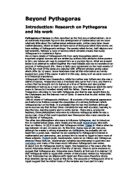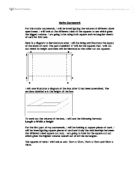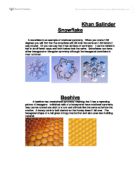The aim of my coursework is to prove or disprove the following hypothesis: there is a better quality of environment in a suburban area than an inner city area.
The aim of my coursework is to prove or disprove the following hypothesis: "THERE IS A BETTER QUALITY OF ENVIRONMENT IN A SUBURBAN AREA THAN AN INNER CITY AREA." What this statement means is that the standard of living would be higher in a suburban area of a town or city than an inner city area. This is because the inner city area is more crowded and densely populated wit less green area, more traffic, noise and pollution than a suburban area. The town I have decided to investigate is my hometown of Billingham. The reason I have chosen Billingham is because I live there, I know the area well and as I live in Billingham I don't need any transport to get to the areas I have chosen. Billingham used to be an important industrial town around the mid twentieth century along with the rest of the Teesside and Hartlepool area. It was renowned for it's shipbuilding and steel works with deep docks of the River Tees. However the shipyards closed due to competitors in Japan offering cheaper prices, cheaper labour and the dated technology at the ship yards in the North- East because the ship yards were privately owned and the owners wanted the biggest amount of profit possible. The North East area could now compete with the rest of the world for ship building but it would cost millions to open a new ship yard with the technology and need for a . Just a few years ago Kaverna
volumes of open ended prisms
Part 1 For part 1 of this piece of math coursework I will be investigating volumes of prisms, which can be made from a 24cm, by 32cm piece of card. I will be trying to determine which shape will make the prism with the largest volume. To do this, I will be exploring the volumes of triangular prism, cylinders, quadrilateral prisms, pentagonal prism, hexagonal prism, heptagonal prism and octagonal prism. I will then try to work out a formula for working out the volume of an "n" sided shape. Triangular prisms First, I will be investigating the volume of triangular prisms. We know that in a triangle, the lengths of the left and right sides must add up to more than the length of the base and we also know that the volume of any prism is the area of cross section multiplied by the length. To find the volume, we must first find the area of the 7cm cross-section. To find the area of a triangle we must h use the formula Area(a) = base (b) x height (h) 2 10cm 32cm To work out the height we must use Pythagoras's theorem Using the rules of Pythagoras, we know
The funding requirements for Hallamore - Report for Steelville City Council.
The funding requirements for Hallamore Report for Steelville City Council . Abstract Setting the context This report has been out together for Steelville City Council it is intended to provide information on funding available for Hallamore and the process required to obtain the funding. The information provided is based on the baseline information provided to the consultant. In accordance it is not possible to provide specific figures due to limitations of the information. The report is set out into five main sections as follows:_ Introduction - Outlining the problem's Method - Mapping & commonalities Results/findings - What funding in place and what's required Discussion - process Conclusions - Recommendations 2. Introduction The problems being experienced by the area are typical of those experienced by many other areas, which have benefited from regeneration funding. The area itself is diverse, in terms of its housing, its population and their social needs. The population is made up of a younger mobile population, established older residents and a small but prominent and closely-knit ethnic minority group (mainly Somali). The demolition and construction of new housing has reduced the housing stock from 4445 to 3608 over a period of roughly ten years. The areas has benefited from one of the earlier SRB schemes that funded the demolition of a number of
Advantages and Disadvantages of To Proposed Sites of a Call Centre
Advantages and disadvantages of to proposed sites of a call centre When writing this report and making a decision on the location of the call centre several factors must be considered, below are several that must be asked in relation to the two suggested locations Factors effecting location - Evidence of existing call centres succeeding - Labour force - Good business network, training and human resources - Financial Incentives - Quality location, is there a premises already available - Quality of life (amenities etc) - Telecom support i.e. technical assistance The first location suggested is Longbenton in the North east of England, North of Tyne and Wear and Teesside, and the other is Bolton in the area of greater Manchester. There are advantages and disadvantages to both sites, with the help of the factors identified above I will identify and evaluate the pros and cons of each site. The Longbenton site, the first facto to consider is the success of other call centres in the area. In a survey of call centre operators the NE England was ranked 6th out of 13 this shows that call centres in the NE England area are preserved to be reasonably successful and thus provide a reason for a possible call centre The Bolton site is situated in an area that may not be regarded as such a successful area to locate a call centre, the survey and results were taken from
Shapes Investigation - Find the relationship between the perimeter (in cm), dots enclosed and the amount of shapes (i.e. triangles etc.) used to make a shape.
GCSE Maths Coursework - Shapes Investigation Summary I am doing an investigation to look at shapes made up of other shapes (starting with triangles, then going on squares and hexagons. I will try to find the relationship between the perimeter (in cm), dots enclosed and the amount of shapes (i.e. triangles etc.) used to make a shape. From this, I will try to find a formula linking P (perimeter), D (dots enclosed) and T (number of triangles used to make a shape). Later on in this investigation T will be substituted for Q (squares) and H (hexagons) used to make a shape. Other letters used in my formulas and equations are X (T, Q or H), and Y (the number of sides a shape has). I have decided not to use S for squares, as it is possible it could be mistaken for 5, when put into a formula. After this, I will try to find a formula that links the number of shapes, P and D that will work with any tessellating shape - my 'universal' formula. I anticipate that for this to work I will have to include that number of sides of the shapes I use in my formula. Method I will first draw out all possible shapes using, for example, 16 triangles, avoiding drawing those shapes with the same properties of T, P and D, as this is pointless (i.e. those arranged in the same way but say, on their side. I will attach these drawings to the front of each section. From this, I will make a list of all
Borders Investigation
"BORDERS" INVESTIGATION Introduction The starting point for this investigation is the following sequence of cross shapes: The sequence begins with a single white square, which is then surrounded by black squares to form the second shape. Each new cross is then formed by completely surrounding the previous cross with a border of black squares. In each new cross, the previous cross can be seen as the area of white squares in the centre. The aim of this investigation is to derive algebraic formulae from the sequence, each expressing one property in terms of another (e.g. defining the area as the diameter squared). These formulae can then be examined and, hopefully, proven, using a wide variety of mathematical tools. The next stage will then be to apply this same process to the three-dimensional counterpart of this sequence of shapes. This sequence would begin with a single white cube, which would then be surrounded on all six sides by black cubes, and the sequence would continue in the same way as the two-dimensional version. 2D Defining n Throughout this investigation, the variable n (the value in the phrase "nth term") is used to refer to terms in sequences. Terms are compared to, and expressed as functions of, n. However, in order to be able to identify the value of n for a random shape, we must define what the first term is in each sequence, and relate n to a physical
Fencing Prblem
Introduction A Farmer has a plot of land. She has only 1000m of fencing. She wants to fence off a plot of land. She is not concerned about the shape but the perimeter has to be exactly 1000m. The fenced off area has to be the maximum contained area. I am going to investigate the shape or shapes that could be used to fence in the maximum area using exactly 1000 metres of fencing each time. Firstly, I am going to investigate 3 - sided shapes - triangles, 4 - sided shapes-quadrilaterals and 5 sided shapes-pentagons. From there on I am going to gather the results and see if I need to investigate any further. TRIANGLES In first part of my coursework I am going to investigate different types of triangles. Firstly I will look at Isosceles triangles. The formula for triangles: There are two ways of working out the area. You will get the same answer with either formula. > Area = 1/2 x base x height > Area = base x height 2 Triangle 1 450m 450m 100m I divide the Isosceles triangle 450 m2 - 50m2 = Height m2 202,500 - 2,500 = 200,000 Height = square root of 200,000 Height = 447.21 to two decimal places. To calculate the area of this Isosceles triangle we calculate: Area = 1/2 x base x height Area = 1/2 x 100 x 447.21 Area = 22,361 m2 (meter squared) to the nearest whole number. Triangle 2 I chose a different size isosceles triangle to continue my
Impacts of tourism Positive and Negative effects in Castleton
Impacts of tourism Positive and Negative effects I have discovered that many locals heavily rely upon tourists to earn their livings and to afford to live in such an expensive area as Castleton, where a small cottage will cost about £100,000. Locals running services for tourists do inflate their prices therefore creating much profit, particularly in the summer months. This is not a problem for locals as their lives and livelihoods have certainly been protected by the attraction of the quaint village in the countryside which is appealing to many city dwellers, i will go into detail on these issues later in this section of my project. There is also a downside to this for the locals. The locals don't have many services for themselves in the village, there are virtually no shops for locals. Also tourists cause many other problems such as traffic - the roads are often congested, litter and noise. There are also some conflicts over land use. The locals do have some benefits from the tourist industry, such as good public transport links, but they wish for something to be done about the many problems in the village. I am using the my primary data and some of my secondary data to do this part of the fieldwork. At the differant sites differant thing were observed about the litter, the noise, the buildings, the crime, the erosion, the traffic, the pollution, the vegetation, the
Research on Pythagoras and his work.
Beyond Pythagoras Introduction: Research on Pythagoras and his work Pythagoras of Samos is often described as the first pure mathematician. He is an extremely important figure in the development of mathematics yet we know relatively little about his mathematical achievements. Unlike many later Greek mathematicians, where at least we have some of the books which they wrote, we have nothing of Pythagoras's writings. The society which he led, half religious and half scientific, followed a code of secrecy which certainly means that today Pythagoras is a mysterious figure. We do have details of Pythagoras's life from early biographies which use important original sources yet are written by authors who attribute divine powers to him, and whose aim was to present him as a god-like figure. What we present below is an attempt to collect together the most reliable sources to reconstruct an account of Pythagoras's life. There is fairly good agreement on the main events of his life but most of the dates are disputed with different scholars giving dates which differ by 20 years. Some historians treat all this information as merely legends but, even if the reader treats it in this way, being such an early record it is of historical importance. Pythagoras's father was Mnesarchus, while his mother was Pythais and she was a native of Samos. Mnesarchus was a merchant who came from Tyre, and
Investigation into the progression of patterns in 3d shapes.
Borders Coursework I am continuing my investigation into the progression of patterns further, in that, I am no longer working with 2D shapes, but instead 3D ones. I have drawn the first four patterns on separate isometric paper and the pattern number relates to its nth term, i.e. pattern 2 is the same as n = 2. In order to draw the shapes I have drawn them in separate layers, to make it easier to count the total number of squares in each pattern. When drawing each pattern, I added 1 square to each free side of the previous pattern. For instance, pattern 1 is a cube which has 6 sides; therefore I added 6 cubes to it. On the following pages you will see the diagrams that show how the 3D patterns are built up. As shown by my drawings, each pattern's number of layers increases. If we look at each individual layer we can see a significant link between the 2D and 3D patterns. First of all I looked at the centre layer, which is built up in exactly the same way as the 2D patterns. I then looked at layer A for all the patterns and found it followed the same pattern of progression, however it does not have the same formula. In pattern 1, layer A = 0 therefore it is a step behind. The progression of layer B is again the same however the formula is different. In pattern 2 layer B = 0, therefore it is two steps behind. The results of my investigation can be shown as follows:
















